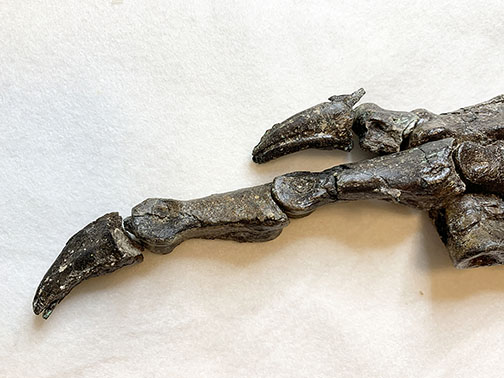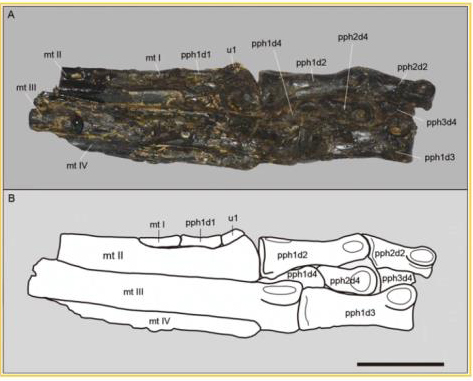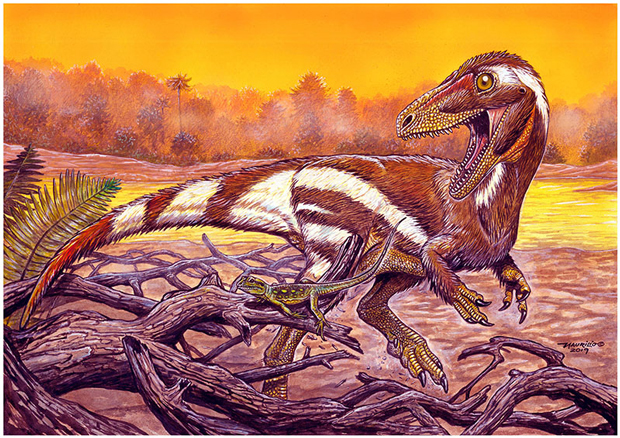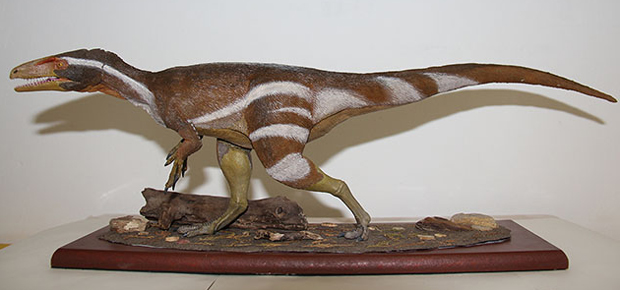Aratasaurus museunacionali “Lizard Born of Fire”
Aratasaurus museunacionali Newly Described Basal Coelurosaur
This month a new basal member of the Coelurosauria has been named and described from limb bones sourced from the Romualdo Formation in north-eastern Brazil. The dinosaur has been named Aratasaurus museunacionali, the genus name translates as “lizard born of fire” a reference to the fact, the fossil had been in the National Museum of Brazil (Museu Nacional), when a fire ripped through the building. Fortunately, the fossil material was not damaged and the research could be successfully concluded and a new genus of Early Cretaceous dinosaur described.
A New Theropod – Aratasaurus museunacionali
Aratasaurus museunacionali Life Reconstruction
Picture credit: Museu Nacional
The species name honours the Museu Nacional in recognition of the tragic fire that took place in September 2018. To read more about the fire: Devastating Fire at Brazil’s National Museum.
Helping to Better Understand the Coelurosauria
Juliana Sayão, a palaeontologist from the Federal University of Pernambuco and lead author of the scientific paper, commented that this new theropod will help scientists to better understand the evolutionary history of the Coelurosauria, an extensive clade of dinosaurs that consists of the tyrannosaurids, compsognathids, the ornithomimosaurs and the Maniraptora which includes birds.
A phylogenetic assessment suggests that Aratasaurus is closely related to Zuolong (Z. salleei), from the Late Jurassic of China, although it lived much more recently, the sediments from which the limb elements were excavated have been dated to approximately 110-115 million years ago (Albian faunal stage of the Cretaceous).
The Right Pes of Aratasaurus museunacionali after Preparation

Picture credit: Museu Nacional
Evidence of Seasonal Fires
The genus name might reflect the ordeal of the fire at the Museu Nacional but tiny pieces of fossilised wood found in association with the dinosaur bones suggest that Aratasaurus had to contend with forest fires within its ecosystem when it roamed this part of Gondwana more than 100 million years ago.
Highlighting the significance of this fossil discovery Juliana Sayão commented:
“Every discovery of a fossil is important because we obtain records that help to reconstruct the history of the planet and remake the path of evolution of the organisms that lived here millions of years ago. Many times the fossil is unique and provides all the information about that species or group of animals”.
Brazil’s Newest Carnivorous Dinosaur
A model of the Brazil’s newest carnivorous dinosaur from the Araripe Basin has been commissioned. Careful examination of the bone structure (histology), suggests that the individual was approximately four years old when it died. Based on the growth rates of other, better known coelurosaurs, the researchers propose that the fossils represent a sub-adult specimen. As such, the size estimate of around three metres in length probably does not represent the maximum size for this dinosaur species.
The Model of Aratasaurus museunacionali
Picture credit: Museu Nacional
The fossils, consisting of a partial femur, a tibia and foot bones representing an incomplete right limb were discovered in 2008 and first taken to the Museum of Palaeontology Plácido Cidade Nuvens, in Santana do Cariri but transferred to the Laboratory of Paleobiology and Microstructures, at the Academic Centre of Vitória, (Federal University of Pernambuco), for further preparation and study.
As part of the research project, the fossil material was taken in 2016 to the Museu Nacional for further analysis. Although caught up in the conflagration that destroyed much of the museum in 2018, the specimen survived and the analysis was able to be completed.
Photograph and Line Drawing Showing the Right Pes (Foot)

Picture credit: Manso Sayão et al (Scientific Reports)
Comments from Everything Dinosaur
A spokesperson from Everything Dinosaur commented:
“The specimen might be fragmentary, but it’s discovery underpins the significance of the Romualdo Formation and helps to extend our knowledge of the dinosaur biota inhabiting this part of Gondwana in the later stages of the Early Cretaceous. As this genus has been classified as the sister taxon of the Chinese Zuolong, it suggests that basal coelurosaurs may have been more widely distributed and had a greater temporal range than previously thought.”
Everything Dinosaur acknowledges the assistance of a media release from the Museu Nacional in the compilation of this article.
The scientific paper: “The first theropod dinosaur (Coelurosauria, Theropoda) from the base of the Romualdo Formation (Albian), Araripe Basin, Northeast Brazil” by Juliana Manso Sayão, Antônio Álamo Feitosa Saraiva, Arthur Souza Brum, Renan Alfredo Machado Bantim, Rafael Cesar Lima Pedroso de Andrade, Xin Cheng, Flaviana Jorge de Lima, Helder de Paula Silva and Alexander W. A. Kellner published in Scientific Reports.
Visit the Everything Dinosaur website: Visit Everything Dinosaur.



